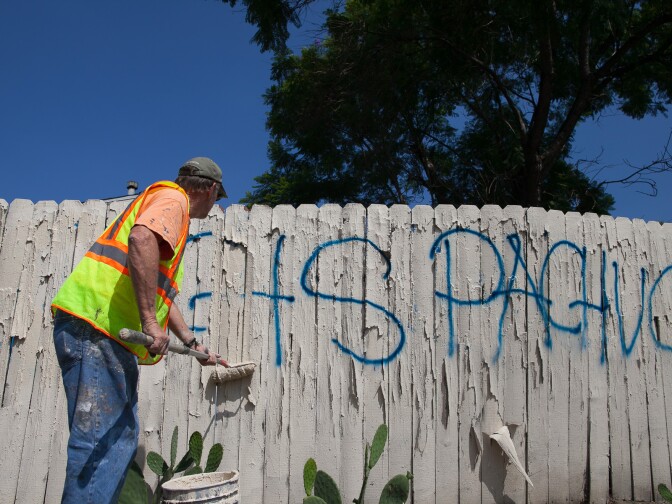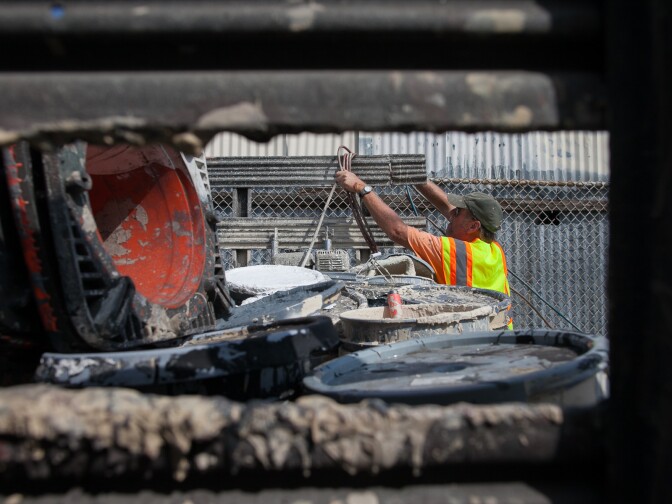With our free press under threat and federal funding for public media gone, your support matters more than ever. Help keep the LAist newsroom strong, become a monthly member or increase your support today.
LA scrubs away 30 million square feet of graffiti each year
Graffiti is everywhere in Los Angeles — on billboards, garage doors, bridges, bus stops. In 2014 alone, city data show crews cleaned up 32.4 million square feet.
The reports from citizens keep coming in, too, hitting record highs in recent years. The number last year surpassed 120,000, and it's on track to be even higher in 2015.
All of this comes with a cost. L.A. spends about $7 million per year dealing with graffiti, a price tag the city sees as a bargain but that others argue could be better spent elsewhere.
On a typical day, as many as 80 one-person abatement crews drive around L.A. They're managed by non-profit contractors who work for the city, with names like South Los Angeles Beautification Team, Gang Alternative Program and Northeast Graffiti Busters.
Neighborhoods in South, East and Central L.A. see a sizable portion of the city's graffiti, according to city data. Many areas in the San Fernando Valley and the Westside see considerably less, though every area has cleanup crews.
One hotspot is Highland Park, where Larry Bender drives around, scouring walls and streets for spray paint and responding to citizen reports. It's messy work.
After just a few hours on a chilly summer morning, Bender's outfit is already ruined, with paint splattered all over his jeans, T-shirt and vest.
Bender drives around with an array of paint cans in the back of his truck, designed to match the surfaces he paints over. For this neighborhood, he uses shades like whale gray, palomino and cowhide tan.
In an alley he estimates he's painted over 30 times, he grabs for his motor-powered paint sprayer. For other jobs, he'll roll paint over graffiti, or chemically treat it and blast it off with water.
Larry Bender painting over graffiti in Northeast Los Angeles (Photo: Susanica Tam)
Graffiti cleanup was a pet issue of Mayor Eric Garcetti’s in his time on the City Council, representing neighborhoods including Westlake and Echo Park. Garcetti launched a volunteer program to fight graffiti in his district.
At a mayoral debate in 2013, he recalled counting the spray paint around his district in one day. "We got very carsick as we drove around every block of every street of every neighborhood, and counted 27,754 graffiti tags in one day in one of fifteen council districts," he says.
Now that he’s mayor, Garcetti sets L.A.’s graffiti cleanup budget. Funding for abatement has changed with the times, but it's now back to pre-recession levels.
RELATED: An animated map of graffiti cleanup in Los Angeles
Paul Racs manages how that money is spent with the city's Office of Community Beautification, where he's worked since before the abatement effort began in 1989. Racs oversees the non-profit contractors that do the "lion’s share" of cleanup in the city.
He told KPCC $7 million a year to clean graffiti is a bargain.
"Graffiti touches on public safety, on economic development, on quality of life issues, how people feel about their neighborhoods," he says.
Unlike other types of property damage, the city considers graffiti such a nuisance that it covers the cost of getting rid of it, as long as it's visible from the street.
Not all graffiti goes away, however. Property owners have to give the go-ahead before crews can clean up for the first time, and not all graffiti is illegal.
In a Highland Park alley, behind a movie theater, Steve Grody gestures at an elaborate work of street art by multiple writers, featuring spiders, lucha libre masks and more. The group of style writers had permission to spray-paint here, so their work stays up.
Grody has been documenting L.A. graffiti since 1990, and he estimates he's taken at least 30,000 pictures in that time. He questions whether all the cleanup is really worth the money.
"Why is that money being used for something rather than school supplies for kids?"
Seven million dollars is more than the city puts towards its Ethics Commission, or the departments of Emergency Management and Disability. And that’s not the full cost. Other government agencies, including Metro, Caltrans and the city's parks department pay to scrub graffiti from their own property in a city of over 500 square miles.
Grody says getting rid of spray paint isn’t always necessary.
"A lot of people in terms of abatement want to throw out the baby with the bathwater. They’re thinking somehow if they stop all graffiti that that's going to be a good thing," he says. Grody says he believes cleanup crews don't draw distinctions between hastily-scrawled gang graffiti and artful style writing.
Grody, who has known generations of graffiti writers and wrote a book on the subject, calls the activity "half art, half sport" and says abatement may just be creating fresh canvases. "It's the old psychological expression: what goes down must come up."
Across the city, there are addresses that have been tagged hundreds of times.
For Larry Bender, the one-man clean up crew, focusing on different styles of graffiti misses the point. "The whole idea is to make it go away like it was never there, like nobody was ever there. So that's our job is to make it invisible" he says.
Most of what Bender sees are simple tags and gang graffiti. He says he doesn't mind coming back to the same places again and again, that's the nature of the work. "One thing about this job, theres always graffiti."















